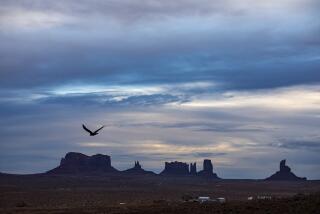How the Gold King Mine spill continues to affect Navajo life

Cement Creek, which was flooded with millions of gallons of mining wastewater, meets with the Animas River in Silverton, Colo.
Three million gallons of contaminated water from the Gold King Mine poured into Colorado’s Animas River in August, laden with cadmium, lead and arsenic. The water eventually found its way into the San Juan River, the primary source of irrigation for Navajo Nation farmers.
The U.S. Environmental Protection Agency admitted that it accidentally caused the spill while trying to prevent leakage of toxic materials.
The spill was one of the biggest environmental disasters in the region and came in the middle of growing season for hay and alfalfa. Some communities reopened their gates to water from the river. Others, including one of the largest Navajo chapters (similar to a county), voted to keep their gates closed for at least a year to avoid contaminating the soil, despite reports from the EPA that the measures of chemicals had returned to pre-incident levels.
Navajo Nation Council Speaker LoRenzo Bates, a farmer, spoke to the Los Angeles Times about the effect of the spill on his life and the Navajo Nation.
What did you think when you first saw the river?
By the time it reached us, you know, it was quite diluted. We didn’t see the orange water; it was more yellow-brown.
My farm is 200 yards from the river, so I saw it coming right down toward us. No one knew the impact if we kept the water on. There could be any one of deadly metals in the water. We knew it was going to change things.
How much did you lose?
I’ll use myself as an example, but farmers upstream, farmers downstream have had similar, if not worse, results. We get four cuttings of hay each season. By my third cut, I was over 200 bales short. Going into my fourth cut, I was 300 bales short. Do the math: I have to get 500 bales, at $9 a bale.
We had newly planted alfalfa, and I won’t know until spring how bad it’s impacted. My son had a vegetable garden, which we pulled up early. All the tomatoes were small, so was the corn.
We were without water for 21 days, so we still felt the impact. When we go further down the valley, two chapters chose to not have their water turned back on. They lost their third and fourth cut. They lost all their vegetables. That’s more than $1,000 off the bat, and that’s just me.
I’m also a rancher and had to put the cows on municipal water instead of letting them drink off the river. They all got thinner. It cost me.
What do you think of the chapters that are keeping the water off?
There will always be, to a certain extent, that suspicion of how pure is the quality of the water. There will always be that suspicion, partly to those who may not understand how the process works.
But when you have the experts, whether it be from Navajo Nation or whoever, to come and swear on the Bible, basically, to say that the water is good, at some point, the water users have to decide whether to use that water. In this case, using myself as an example, I cross-checked the data and decided to turn the water back on.
What has been the biggest problem since the EPA has declared the water safe?
We don’t know what the future chemicals coming down the river will be. If you trust that the water is back [to pre-spill levels], as I do, then OK. But what about chemicals that might be in the river sediment? That is where we don’t know.
Should the government involve the Navajo Nation in resolving problems from the spill?
It impacts us more so on the resources, in this case, the river. If you divided the San Juan River right down the middle, half of that belongs to the Navajo Nation. So it affects all the resources attached to that river. That’s farming, fishing, any tourism dollars.
Now, using the Navajo as an example, if it had been made known prior to the spill this was a possibility, I am certain the Navajo Nation would have taken whatever action necessary to make sure its resources would be protected. If decisions are being made that could affect us or our kids, we deserve a say.
Are you confident you will be properly compensated?
We all know who’s responsible. We all know the severity of their action. The question is, at what point are those who were impacted going to get compensated?
Going through a lawsuit, will individual farmers on small plots be part of that lawsuit? I’m guessing not. Then it becomes the decision of the individual farmer whether they want to sue.
What about the claims process?
Form 95 (the EPA damage-claim form) has been in discussion since Day One.
In my opinion, at some point you’re going to have to fill it out, so before the end of this year, I will fill out Form 95.
Why has the president of the Navajo Nation, Russell Begaye, and the nation’s attorney recommended that people not submit the form?
Their position, which they can explain themselves, has been that they are concerned about the claims in the future.… They want to make sure that things we can’t predict now won’t hurt us in the future and that we will be able to be compensated for that.
But you are on the fence? Is the speed with which you’ll get the money the primary issue?
Once I turn that in, once others turn that in, how soon will I get compensated? If and when I receive a check, the way this form reads in small print, is all first and future claims will be considered.
But you acknowledge that people have a reasonable fear about their ability to make future claims?
The question is, what if there are new findings? What if those contaminants are upstream and it’s determined that the water quality is degraded from upstream? There has to be some consideration, long-term, about those possibilities.
Twitter: @nigelduara
More to Read
Start your day right
Sign up for Essential California for news, features and recommendations from the L.A. Times and beyond in your inbox six days a week.
You may occasionally receive promotional content from the Los Angeles Times.







